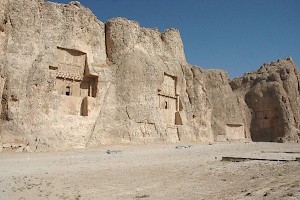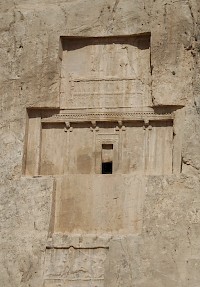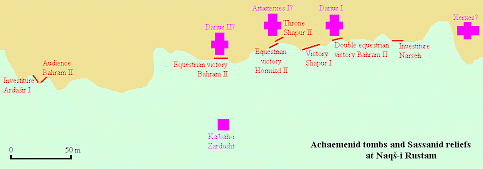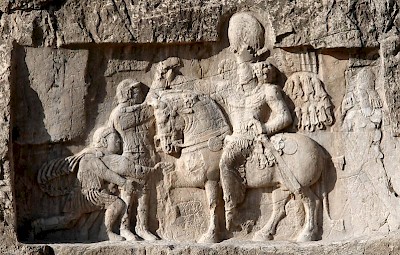Naqš-e Rustam
Q648705Naqš-e Rustam: archaeological site in Fars (Iran), best known for its Achaemenid tombs and rock reliefs made in the Sasanian age.
Achaemenid Age

Naqš-e Rustam, probably the ancient Nupistaš, is situated about five kilometers northwest of Persepolis, the capital of the ancient Achaemenid empire. As is shown by a pre-Achaemenid relief and several old graves, Naqš-e Rustam was already a place of some importance when king Darius I the Great (r.522-486) ordered his monumental tomb to be carved into the cliff, which is known as the Huseyn Kuh.
This tomb is well-known for the king's "autobiography", which is contained in two inscriptions (DNa and DNb). The central thought is that Darius wanted to rule according to justice: "It is not my desire that a man should do harm, nor is it my desire that he goes unpunished when he does harm".

Later, similar royal rock tombs were added. Because they carry no inscriptions, they cannot be identified with any certainty, but they must obviously have belonged to Darius' son and successor Xerxes (r.486-465), his son Artaxerxes I Makrocheir (r.465-424) and his grandson Darius II Nothus (r.423-404). Each tomb could contain three to nine people. The later Achaemenid kings, Artaxerxes II Mnemon, Artaxerxes III Ochus and Darius III Codomannus were probably buried in tombs at Persepolis.
Archaeologists are almost certain that the tombs were closed after the burial. After Alexander the Great had overthrown the Achaemenid empire, the doors were smashed and the tombs were looted.
In front of the tombs is a small tower, which is known as the Ka'bah-i Zardusht ("Zarathustra's ka'bah" - the real ka'bah being the famous monument in Mecca). Probably, this tower was used to keep the holy fire or books (e.g., the Avesta). There was a garden near the tombs and tower.

In front of the Achaemenid tombs, there must have been a park (paradeisos). One of the Persepolis fortification tablets mentions that trees are to be planted at Nupistaš, which seems to be Naqš-e Rustam.
Two kilometers south of Naqš-e Rustam, at a place called Takht-e Rustam, the remains of an unfinished building can be seen. This may or may not have been the base of the tomb of Cambyses, which was similar in design to the tomb of his father, Cyrus the Great, at Pasargadae.
Sasanian Age

After the fall of the Achaemenid empire, Naqš-e Rustam remained important to the Persians. After 260 CE, the Sasanian king Shapur I had a monumental relief cut out in the rock, showing how he made Philippus Arabs ruler of the Roman empire and received the defeated Roman emperor Valerian. Other reliefs were added by Shapur's successors.
Some of these reliefs show elaborate equestrian fights of a type that was still common in the Middle Ages, when the famous poet Firdausi (940-1021) wrote the Shahname: the Iranian national epic, full of tales of chivalry. It is likely that people who knew those stories, when they saw the equestrian reliefs, thought that they represented the legendary hero Rustam. This may explain why the site was called Naqš-e Rustam, "carvings of Rustam".